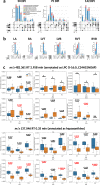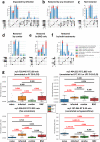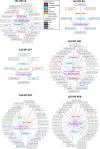Localized cardiac small molecule trajectories and persistent chemical sequelae in experimental Chagas disease
- PMID: 37880260
- PMCID: PMC10600178
- DOI: 10.1038/s41467-023-42247-w
Localized cardiac small molecule trajectories and persistent chemical sequelae in experimental Chagas disease
Abstract
Post-infectious conditions present major health burdens but remain poorly understood. In Chagas disease (CD), caused by Trypanosoma cruzi parasites, antiparasitic agents that successfully clear T. cruzi do not always improve clinical outcomes. In this study, we reveal differential small molecule trajectories between cardiac regions during chronic T. cruzi infection, matching with characteristic CD apical aneurysm sites. Incomplete, region-specific, cardiac small molecule restoration is observed in animals treated with the antiparasitic benznidazole. In contrast, superior restoration of the cardiac small molecule profile is observed for a combination treatment of reduced-dose benznidazole plus an immunotherapy, even with less parasite burden reduction. Overall, these results reveal molecular mechanisms of CD treatment based on simultaneous effects on the pathogen and on host small molecule responses, and expand our understanding of clinical treatment failure in CD. This link between infection and subsequent persistent small molecule perturbation broadens our understanding of infectious disease sequelae.
© 2023. Springer Nature Limited.
Conflict of interest statement
K.M.J., A.L.K., A.C.L., J.P., M.E.B., and P.J.H. currently are involved in a Chagas vaccine development program. M.E.B. and P.J.H. are listed among the inventors on a Chagas disease vaccine patent, submitted by Baylor College of Medicine. The remaining authors declare no competing interests.
Figures







Update of
-
Localized cardiac metabolic trajectories and post-infectious metabolic sequelae in experimental Chagas disease.Res Sq [Preprint]. 2023 Jan 20:rs.3.rs-2497474. doi: 10.21203/rs.3.rs-2497474/v1. Res Sq. 2023. Update in: Nat Commun. 2023 Oct 25;14(1):6769. doi: 10.1038/s41467-023-42247-w. PMID: 36711878 Free PMC article. Updated. Preprint.
Similar articles
-
Localized cardiac metabolic trajectories and post-infectious metabolic sequelae in experimental Chagas disease.Res Sq [Preprint]. 2023 Jan 20:rs.3.rs-2497474. doi: 10.21203/rs.3.rs-2497474/v1. Res Sq. 2023. Update in: Nat Commun. 2023 Oct 25;14(1):6769. doi: 10.1038/s41467-023-42247-w. PMID: 36711878 Free PMC article. Updated. Preprint.
-
Anti-parasitic effect of vitamin C alone and in combination with benznidazole against Trypanosoma cruzi.PLoS Negl Trop Dis. 2018 Sep 21;12(9):e0006764. doi: 10.1371/journal.pntd.0006764. eCollection 2018 Sep. PLoS Negl Trop Dis. 2018. PMID: 30240395 Free PMC article.
-
Treatment with benznidazole during the chronic phase of experimental Chagas' disease decreases cardiac alterations.Antimicrob Agents Chemother. 2005 Apr;49(4):1521-8. doi: 10.1128/AAC.49.4.1521-1528.2005. Antimicrob Agents Chemother. 2005. PMID: 15793134 Free PMC article.
-
Trypanocidal drugs for late-stage, symptomatic Chagas disease (Trypanosoma cruzi infection).Cochrane Database Syst Rev. 2020 Dec 11;12(12):CD004102. doi: 10.1002/14651858.CD004102.pub3. Cochrane Database Syst Rev. 2020. PMID: 33305846 Free PMC article.
-
An update on benznidazole for the treatment of patients with Chagas disease.Drugs Today (Barc). 2018 Jan;54(1):15-23. doi: 10.1358/dot.2018.54.1.2753402. Drugs Today (Barc). 2018. PMID: 29569658 Review.
Cited by
-
System-based insights into parasitological and clinical treatment failure in Chagas disease.mSystems. 2025 Feb 18;10(2):e0003824. doi: 10.1128/msystems.00038-24. Epub 2025 Jan 7. mSystems. 2025. PMID: 39772644 Free PMC article. Review.
-
Small molecule mediators of host-T. cruzi-environment interactions in Chagas disease.PLoS Pathog. 2024 Mar 8;20(3):e1012012. doi: 10.1371/journal.ppat.1012012. eCollection 2024 Mar. PLoS Pathog. 2024. PMID: 38457443 Free PMC article. Review.
-
Severe acute respiratory syndrome coronavirus 2 infection unevenly impacts metabolism in the coronal periphery of the lungs.iScience. 2025 Jan 2;28(2):111727. doi: 10.1016/j.isci.2024.111727. eCollection 2025 Feb 21. iScience. 2025. PMID: 39995861 Free PMC article.
-
Different responses involving Tfh cells delay parasite-specific antibody production in Trypanosoma cruzi acute experimental models.Front Immunol. 2025 Apr 28;16:1487317. doi: 10.3389/fimmu.2025.1487317. eCollection 2025. Front Immunol. 2025. PMID: 40356908 Free PMC article.
-
Treatments and the Perspectives of Developing a Vaccine for Chagas Disease.Vaccines (Basel). 2024 Aug 1;12(8):870. doi: 10.3390/vaccines12080870. Vaccines (Basel). 2024. PMID: 39203996 Free PMC article. Review.
References
-
- Phetsouphanh C, et al. Immunological dysfunction persists for 8 months following initial mild-to-moderate SARS-CoV-2 infection. Nat. Immunol. 2022;23:210–216. - PubMed
-
- Morillo CA, et al. Randomized trial of benznidazole for chronic chagas’ cardiomyopathy. N. Engl. J. Med. 2015;373:1295–1306. - PubMed
Publication types
MeSH terms
Substances
Grants and funding
LinkOut - more resources
Full Text Sources
Medical

